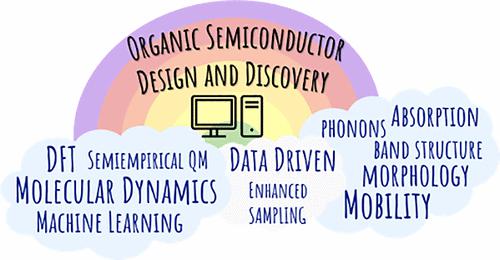当前位置:
X-MOL 学术
›
Chem. Rev.
›
论文详情
Our official English website, www.x-mol.net, welcomes your
feedback! (Note: you will need to create a separate account there.)
Computational Approaches for Organic Semiconductors: From Chemical and Physical Understanding to Predicting New Materials
Chemical Reviews ( IF 51.4 ) Pub Date : 2023-05-04 , DOI: 10.1021/acs.chemrev.2c00704 Vinayak Bhat 1 , Connor P Callaway 1 , Chad Risko 1
Chemical Reviews ( IF 51.4 ) Pub Date : 2023-05-04 , DOI: 10.1021/acs.chemrev.2c00704 Vinayak Bhat 1 , Connor P Callaway 1 , Chad Risko 1
Affiliation

|
While a complete understanding of organic semiconductor (OSC) design principles remains elusive, computational methods─ranging from techniques based in classical and quantum mechanics to more recent data-enabled models─can complement experimental observations and provide deep physicochemical insights into OSC structure–processing–property relationships, offering new capabilities for in silico OSC discovery and design. In this Review, we trace the evolution of these computational methods and their application to OSCs, beginning with early quantum-chemical methods to investigate resonance in benzene and building to recent machine-learning (ML) techniques and their application to ever more sophisticated OSC scientific and engineering challenges. Along the way, we highlight the limitations of the methods and how sophisticated physical and mathematical frameworks have been created to overcome those limitations. We illustrate applications of these methods to a range of specific challenges in OSCs derived from π-conjugated polymers and molecules, including predicting charge-carrier transport, modeling chain conformations and bulk morphology, estimating thermomechanical properties, and describing phonons and thermal transport, to name a few. Through these examples, we demonstrate how advances in computational methods accelerate the deployment of OSCsin wide-ranging technologies, such as organic photovoltaics (OPVs), organic light-emitting diodes (OLEDs), organic thermoelectrics, organic batteries, and organic (bio)sensors. We conclude by providing an outlook for the future development of computational techniques to discover and assess the properties of high-performing OSCs with greater accuracy.
中文翻译:

有机半导体的计算方法:从化学和物理理解到预测新材料
虽然对有机半导体 (OSC) 设计原理的完整理解仍然难以实现,但计算方法(从基于经典和量子力学的技术到更新的数据驱动模型)可以补充实验观察,并为 OSC 结构处理提供深入的物理化学见解。属性关系,为计算机 OSC 发现和设计提供新功能。在这篇综述中,我们追溯了这些计算方法的演变及其在 OSC 中的应用,从早期研究苯共振的量子化学方法开始,到最近的机器学习 (ML) 技术及其在更加复杂的 OSC 科学中的应用和工程挑战。一路上,我们强调这些方法的局限性以及如何创建复杂的物理和数学框架来克服这些局限性。我们阐述了这些方法在源自 π 共轭聚合物和分子的 OSC 中的一系列具体挑战的应用,包括预测载流子传输、建模链构象和体积形态、估计热机械性能以及描述声子和热传输等。一些。通过这些例子,我们展示了计算方法的进步如何加速 OSCs 在广泛技术中的部署,例如有机光伏 (OPV)、有机发光二极管 (OLED)、有机热电、有机电池和有机(生物)传感器。
更新日期:2023-05-04
中文翻译:

有机半导体的计算方法:从化学和物理理解到预测新材料
虽然对有机半导体 (OSC) 设计原理的完整理解仍然难以实现,但计算方法(从基于经典和量子力学的技术到更新的数据驱动模型)可以补充实验观察,并为 OSC 结构处理提供深入的物理化学见解。属性关系,为计算机 OSC 发现和设计提供新功能。在这篇综述中,我们追溯了这些计算方法的演变及其在 OSC 中的应用,从早期研究苯共振的量子化学方法开始,到最近的机器学习 (ML) 技术及其在更加复杂的 OSC 科学中的应用和工程挑战。一路上,我们强调这些方法的局限性以及如何创建复杂的物理和数学框架来克服这些局限性。我们阐述了这些方法在源自 π 共轭聚合物和分子的 OSC 中的一系列具体挑战的应用,包括预测载流子传输、建模链构象和体积形态、估计热机械性能以及描述声子和热传输等。一些。通过这些例子,我们展示了计算方法的进步如何加速 OSCs 在广泛技术中的部署,例如有机光伏 (OPV)、有机发光二极管 (OLED)、有机热电、有机电池和有机(生物)传感器。











































 京公网安备 11010802027423号
京公网安备 11010802027423号